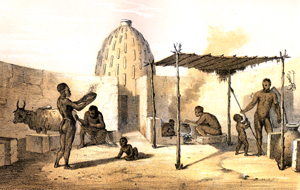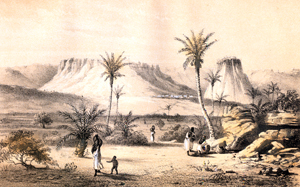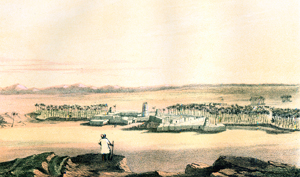"Mizda / April 8th 1850"
Mizda, most probably identical with the eastern "Musti kome" of Ptolemy, appears to have been an ancient settlement of the indigenous inhabitants of North Africa, the Berbers, and more particularly of a family or tribe of them called "Kuntarár" . . . The oasis lies in the upper part of Wadi Sofejín . . . The natural advantage, or productive principle, of the locality seems to lie in the circumstance that the humidity carried down by the Wadi Sheráb is here arrested by a hill, and absorbed by the clayey soil. This hill is of a lengthened form, and consists entirely of gypsum. . . . from a more elevated height further west, called Madúm, I made the accompanying sketch of the whole locality. The wells have little depth, and the water is drawn to the surface by means of oxen . . . This oasis is very diminutive; but the two caravan-routes, one from Murzuk and one from Ghadámes, join at this point. The inhabitants are of a mild disposition, and enjoy the fame of strict honesty. [Vol. I, pp. 100, 102]

“Aúderas / Novr 2nd 1850”
At length we descended from the rugged ground of Tághist into the commencement of the celebrated Valley of Aúderas, the fame of which penetrated to Europe many years ago. . . . On our return I saw in this valley a barbarous mode of tillage, three slaves being yoked to a sort of plough, and driven like oxen by their master. This is probably the most southern place in Central Africa where the plough is used; for all over Sudán the hoe or fertaña is the only instrument used for preparing the ground. While the weather was clear and fine, the valley, bordered on both sides by steep precipices, and adorned with a rich grove of dúm-trees, and bush and herbage in great variety, displayed its mingled beauties, chiefly about the well, where, on our return-journey, I made the accompanying sketch. [Vol. 1, pp. 387-88]

“Kanó, from Mount Dalá / Febr 10th 1851”
Kanó for us was a station of importance not only from a scientific but also from an economical point of view. Instead of being provided with ready cash, we had received in Múrzuk, on account of the British government, merchandise which, we had been assured, would not only be safer than money, but would also prove more advantageous for us. . . . [Hence] nothing could be more disagreeable and disheartening to me, though I was not quite unprepared for it, than the information which I received the very evening of my arrival in Kanó, that the price of merchandise such as I had was very low. . . . The distances in Kanó, though less than those of London, are very great; and the ceremonies to be gone through are scarcely less tedious than those at any European court. . . . [T]he whole scenery of the town in its great variety of clay houses, huts, sheds, green open places offering pasture for oxen, horses, camels, donkeys, and goats, in motley confusion, deep hollows containing ponds overgrown . . . the people in all varieties of costume, from the naked slave up to the most gaudily dressed Arab,— all formed a most animated and exciting scene. [Vol. 2, pp. 97, 99, 101-3]

"Mbutúdi / June 12th 1851"
We had now reached Mbutúdi, a village situated round a granite mount of about six hundred yards' circumference, and rising to a height of about three hundred feet. It had been a considerable place before the rise of the Fúlbe, encompassing on all sides the mount, which had served as a natural citadel; but it has been greatly reduced, scarcely more than one hundred huts altogether now remaining; and were it not for the picturesque landscape — the steep rocky mount overgrown with trees, and the slender deléb-palms shooting up here and there, and forming some denser groups on the south-east side, — it would be a most miserable place. . . . I here tried, for the first time, the fruit of the deléb palm, which was just ripe; but I did not find it worth the trouble, as it really requires a good deal of effort to suck out the pulp, which is nothing but a very close and coarse fibrous tissue, not separating from the large stone, and having a mawkish taste, which soon grows disagreeable. It cannot be at all compared with the banana . . . However, it is of importance to the natives, and, like the fruit of the dúm-palm, it yields a good seasoning for some of their simple dishes. [Vol. II, p. 425-427]

“Herd of Elephants Near the Tsád / Sepr 25th 1851”
It was about seven o’clock in the morning when we had the good fortune to enjoy one of the most interesting scenes which these regions can possibly afford. Far to our right was a whole herd of elephants, arranged in regular array, like an army of rational beings, slowly proceeding to the water. In front appeared the males, as was evident from their size, in regular order; at a little distance followed the young ones; in a third line were the females; and the whole were brought up by five males of immense size. The latter (though we were at some distance, and proceeding quietly along) took notice of us, and some were seen throwing dust into the air; but we did not disturb them. There were altogether ninety-six. [Vol. 3, pp. 48-49]

“Interior of a Músgu Dwelling”
It was a round uncovered apartment of about twenty-four feet in diameter, inclosed by a clay wall of about seven feet high, and a foot in thickness, and carefully polished at the corners. The doorway was about four feet high by about two feet wide. . . . The space included between the bank and the wall formed a sort of stable. . . . The clay bank, therefore, served two purposes, partly as a separation of the stable from the inner apartment, and partly as a seat. The centre of the apartment was formed by a shed about eight feet by six, and consisting of a roof of reeds and grass, supported by four stakes. . . . On the right of this shed was the cooking-place or kitchen, enclosed by two very low clay walls. . . . Between the kitchen, shed, and one end of the clay bank, and divided from the former by a separate wall, appeared a broad entrance to the adjoining building, which we have recognized as a granary. . . . [T]he thermometer, at six o’clock in the morning of the 15th [January 1852], indicated as much as 51E, which was the greatest amount of cold we had during this expedition. . . . Thus ended this [side] expedition, which opened to us a slight glimpse into the richly-watered zone of the equatorial regions, which had supposed to form an insurmountable barrier of a high mountain-chain, and brought us into contact with tribes, whose character had been represented as almost approaching to that of wild beasts. [Vol. 3, pp. 250-52, 258-59]

“Market of Sókoto / April 22nd 1853”
It was the great market-day, which was of some importance to me, as I had to buy a good many things, so that I was obliged to send there a sum of 70,000 shells; but the market did not become well-frequented or well-stocked till between two and three o’clock in the afternoon, when I myself proceeded thither. . . . [E]ven in the present reduced condition of the place, the market still presented a very interesting sight, the numerous groups of people, buyers as well as sellers, and the animals of various descriptions, being picturesquely scattered over the rocky slope. . . . The market was tolerably well attended, and well supplied, there being about thirty horses, three hundred head of cattle for slaughtering, fifty takérkere, or oxen of burden, and a great quantity of leather articles (this being the most celebrated branch of manufacture in Sókoto), especially leather bags, cushions, and similar articles, the leather dressed and prepared here being very soft and beautiful. There were more than a hundred bridles for sale, the workmanship of which is very famous throughout all this part of Negroland; but especially a large quantity of iron was exposed for sale, the iron of Sókoto being of excellent quality and much sought for, while that of Kanó is of bad quality. A good many slaves were exhibited, and fetched a higher price than might be supposed,—a lad of very indifferent appearance being sold for 33,000 shells; I myself bought a pony for 30,000. It being just about the period when the salt-caravan visits these parts, dates also, which usually form a small addition to the principal merchandise of those traders of the desert, were to be had; and I filled a leather bag, for some 2000 shells, in order to give a little more variety to my food on the long road which lay before me. [Vol. 4, pp. 179-180]

“Timbúktu from the Terrace of the Traveller’s House”
In order to obviate the effect of this want of exercise as much as possible, to enjoy fresh air and at the same time to become more familiar with the principal features of the town, through which I was not allowed to move about at pleasure, I ascended as often as possible the terrace of my house. This afforded an excellent view over the northern quarters of the town. On the north was the massive mosque of Sánkoré, which had just been restored to its former grandeur through the influence of the Sheik el Bakáy, and gave the whole place an imposing character. . . . [T]owards the east the view extended over a wide expanse of the desert, and towards the south the elevated mansions of the Ghadámsíye merchants were visible. The style of the buildings was various. I could see clay houses of different characters, some low and unseemly, others rising with a second story in front to greater elevation, and making even an attempt at architectural ornament, the whole being interrupted by a few round huts of matting. The sight of this spectacle afforded me sufficient matter of interest, although, the streets being very narrow, only little was to be seen of the intercourse carried on in them. . . . At the same time I became aware of the great inaccuracy which characterises the view of the town as given by M. Caillié [see CAILLIÉ]. . . . the only error being that in his representation the whole town seems to consist of scattered and quite isolated houses, while, in reality, the streets are entirely shut in, as the dwellings form continuous and uninterrupted rows. [Vol. 4, pp. 440-42]

"Bamba / May 24th 1854"
While awaiting the camels, I sat down on a cliff overhanging the steep bank, which here was about twenty-five feet in height, and enjoyed the splendid view over that great watery highroad of West-Central Africa [the Niger River]. . . . I had my tent pitched near the fine group of date palms, and from this point I made the subjoined sketch, which will impart to the reader a tolerably correct idea of the place. Here we remained the following day, when I was roused at a very early hour by the crowing of the cocks in Bamba, which could not but recall to my mind the fate of the enterprising but unfortunate Mungo Park, who is said by the natives to have stayed here a couple of hours in order to provide himself with fowls . . . though it is more probable that his chief reason for making a halt near the principal places along the river, was to open communication with the natives . . . Rising at an early hour, while the sky was beautifully clear, I enjoyed an hour's pleasing reverie on my favourite rock of the previous day, overhanging the river. [Vol. V, pp. 160, 162]

"Ashenúmma / June 15th 1855"
It was a remarkable fact, but easily explained, that the greatest heat which I experienced in the desert was in this valley, the thermometer at two o'clock in the afternoon rising daily between 110 and 112 . We remained here the following day, when I enjoyed the scenery of the locality extremely, and made a sketch of it, which is represented in the plate opposite. . . . It is a very remarkable circumstance, and one that must not be forgotten by any traveller who pursues this road, that the inhabitants of the Tebu country esteem nothing more highly, nay, scarcely value anything at all, except dried fish, the stinking "búni," and that he may starve with all sorts of treasures in his bags, unless he be possessed of this article. I myself was even obliged to buy the grass or ghedeb (of which I stood in need for my camels) with dried fish . . . [Vol. V, pp. 432-433]
